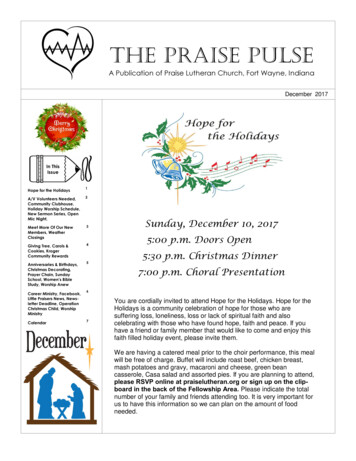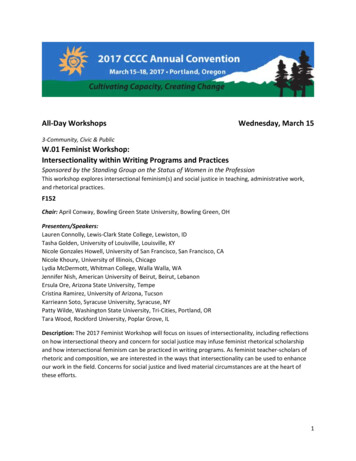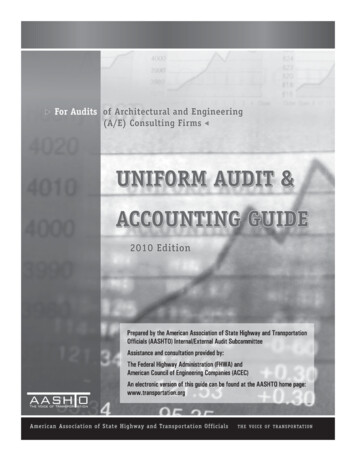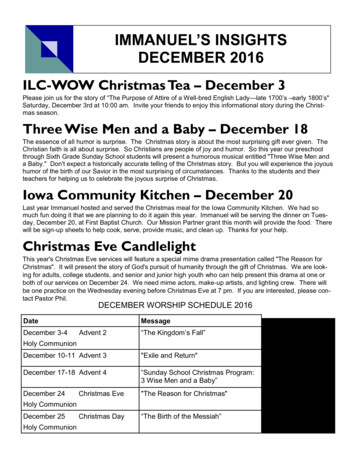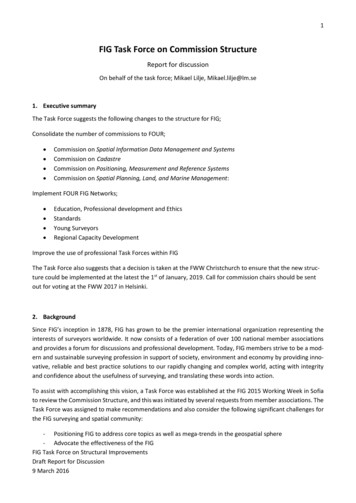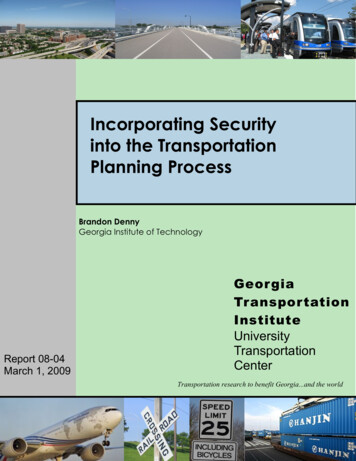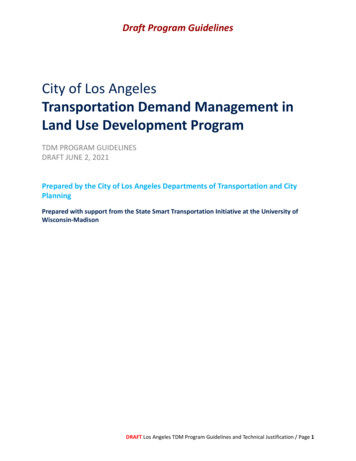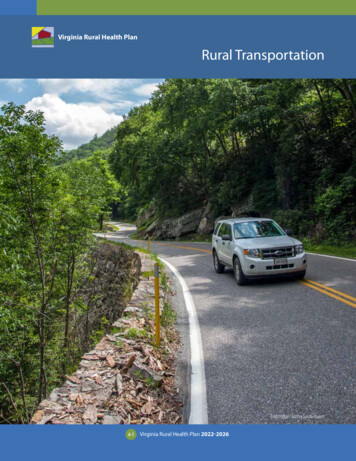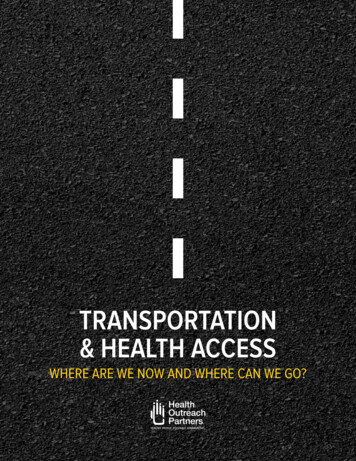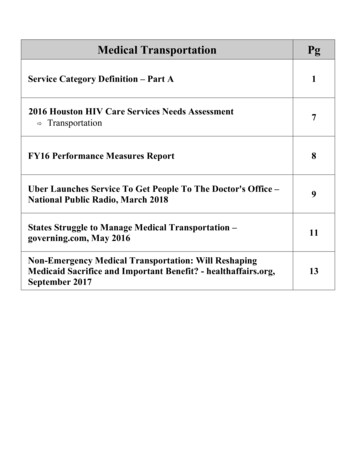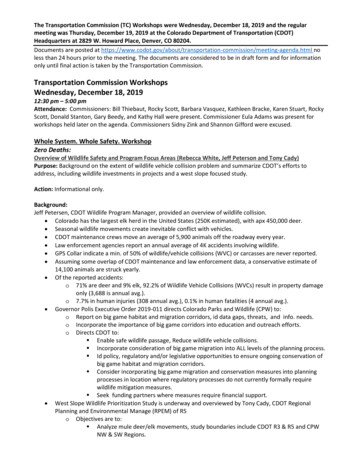
Transcription
The Transportation Commission (TC) Workshops were Wednesday, December 18, 2019 and the regularmeeting was Thursday, December 19, 2019 at the Colorado Department of Transportation (CDOT)Headquarters at 2829 W. Howard Place, Denver, CO 80204.Documents are posted at ion/meeting-agenda.html noless than 24 hours prior to the meeting. The documents are considered to be in draft form and for informationonly until final action is taken by the Transportation Commission.Transportation Commission WorkshopsWednesday, December 18, 201912:30 pm – 5:00 pmAttendance: Commissioners: Bill Thiebaut, Rocky Scott, Barbara Vasquez, Kathleen Bracke, Karen Stuart, RockyScott, Donald Stanton, Gary Beedy, and Kathy Hall were present. Commissioner Eula Adams was present forworkshops held later on the agenda. Commissioners Sidny Zink and Shannon Gifford were excused.Whole System. Whole Safety. WorkshopZero Deaths:Overview of Wildlife Safety and Program Focus Areas (Rebecca White, Jeff Peterson and Tony Cady)Purpose: Background on the extent of wildlife vehicle collision problem and summarize CDOT’s efforts toaddress, including wildlife investments in projects and a west slope focused study.Action: Informational only.Background:Jeff Petersen, CDOT Wildlife Program Manager, provided an overview of wildlife collision. Colorado has the largest elk herd in the United States (250K estimated), with apx 450,000 deer. Seasonal wildlife movements create inevitable conflict with vehicles. CDOT maintenance crews move an average of 5,900 animals off the roadway every year. Law enforcement agencies report an annual average of 4K accidents involving wildlife. GPS Collar indicate a min. of 50% of wildlife/vehicle collisions (WVC) or carcasses are never reported. Assuming some overlap of CDOT maintenance and law enforcement data, a conservative estimate of14,100 animals are struck yearly. Of the reported accidents:o 71% are deer and 9% elk, 92.2% of Wildlife Vehicle Collisions (WVCs) result in property damageonly (3,688 is annual avg.).o 7.7% in human injuries (308 annual avg.), 0.1% in human fatalities (4 annual avg.). Governor Polis Executive Order 2019-011 directs Colorado Parks and Wildlife (CPW) to:o Report on big game habitat and migration corridors, id data gaps, threats, and info. needs.o Incorporate the importance of big game corridors into education and outreach efforts.o Directs CDOT to: Enable safe wildlife passage, Reduce wildlife vehicle collisions. Incorporate consideration of big game migration into ALL levels of the planning process. Id policy, regulatory and/or legislative opportunities to ensure ongoing conservation ofbig game habitat and migration corridors. Consider incorporating big game migration and conservation measures into planningprocesses in location where regulatory processes do not currently formally requirewildlife mitigation measures. Seek funding partners where measures require financial support. West Slope Wildlife Prioritization Study is underway and overviewed by Tony Cady, CDOT RegionalPlanning and Environmental Manage (RPEM) of R5o Objectives are to: Analyze mule deer/elk movements, study boundaries include CDOT R3 & R5 and CPWNW & SW Regions.
CDOT: Safety for traveling public and CPW: Promoting healthy wildlife populations.A Mule Deer Strategy Goal is to: Id conflicts and evaluate scenarios (based on development and traffic). Id how/where mitigation dollars should be allocated. Integrate wildlife mitigation into upcoming projects.o Long-term goal is to improve motorist safety and reduce conflicts with wildlifeo Sources of data include: Road Kill Data, Colorado State Patrol (CSP) Crash Reports, CPW Radio-Telemetry Data(migratory movements), CPW Species Activity Maps (SAM) and Modeled HabitatSuitability.o An investment of 29K along SH 9, US 285, US 160, and US 40 has a 50-75 year lifespan with ananticipated 70% to 95% reduction in wildlife vehicle collisions.Discussion:o Jeff Peterson: Property damage to motorists costs roughly 70M annually, and total cost isestimated at roughly 99M per year, based on the most recently available data.o Eighty percent of state highways affected by WVCs.o Tony Cady: There are declines in mule deer population. Mule deer used to number around 600K,but now the population is down to 400K. Described CDOT/CPW partnership called the Colorado Wildlife and TransportationAlliance and that more mule deer are killed on roads than by hunters. It is estimated that for crash rates, 60% are wildlife related. R5 is experiencing some success in reducing WVCs. 9K annual daily traffic or more should require a permanent wildlife barrier. R3 and R5 and CPW have worked together. A map of Road Kill Data locations was presented. A map identifying where to prioritize addressing WVCs has been developed.o Commissioner Hall noted that we were lucky on SH 9 because funds were not state or federal.o CWP does not recommend providing fencing only, but to also include underpasses.o Ramps only allow animals trapped between fencing to escape.o Steve Harelson, CDOT Chief Engineer, in last 20 years we have built culverts for water flow andfor wildlife passage.o Commissioner Vasquez asked about depth for wildlife to compared to water flow only. Sixteen ft high and 32 ft wide is required in CDOT R5 for culverts. The openness ratioand overpass best for elk is provided only at one site in the state now.o Commissioner Stanton asked if it was possible to get dollars from other stakeholders. Per Tony Cady, R5 Regional Planning and Environmental Manager (RPEM), in southwestColorado they are building overpasses and underpasses and are receiving funding fromCPW for this. CPW provided money to finish this study with statewide prioritization forwildlife crossing infrastructure.o CDOT staff is writing grant proposals for more money and developing an inter-govt agreement(IGA) with CPW to help define financial contributions from each agency.o For CDOT and CPW, co-funding is being considered.o Commissioner Stanton asked if reducing speed limits makes any difference – e.g., 5 mph lower. A seasonal nighttime speed limit study was done, per Mike McVaugh, R5 TransportationDirector. Speed reductions reduced WVCs in some, but not all, locations. It was noted that enforcing the reduced speed limit is often difficult.o Constructed wildlife crossing projects were highlighted on mapping.o Commissioner Vasquez asked about the federal bill covering wildlife mitigation. The answer was that a federal level authorization of 250M to be set aside formitigation of wildlife vehicle collisions nationally is proposed.o Jeff Petersen provided an overview of wildlife mitigation funding sources in Colorado to date.o Rebecca White provided an update regarding a follow-up on E.O. 2019-011. CDOT just signed amemorandum of understanding (MOU) with CPW on how to move data back and forth.o
National Renewable Energy Lab (NREL) PresentationPurpose: Commissioner Vasquez thought inviting NREL would be meaningful the TC Mobility Committee. Patricia Romero-Lankao, from NREL noted that the world is experiencing a transition to EVs. Three examples of research being conducted include:o Technology, political, social science and their ramifications.o UK studied how society responds and why some adapt technology faster than others.o Focus on EV adoption – barriers are socio-economic factors, techno-infrastructure and othermobility relevant attributes.o Research indicates that EV adoption is highest among the affluent and educated with access totransit.o Colorado has clusters of high EV adoption; not as densely populated as New York City. Working class uses alternative transportation modes more. NREL plans to bring more analysis and data back to the TC in the future.o Boulder County survey. We can now use social sciences to evaluate effects of the 2013 flood.o 17 participants were interviewed. Transportation was a foundation of interdependencyamplifying flood risk. In many sectors, actions and policies mitigated negative impacts of thefloods; therefore, actions and policies do matter.o What would you do differently?: Organizations generally focused on one system at a time ratherthan observing the interdependencies among systems, e.g., local economy impacts.o Patricia Romero-Lankao of NREL thanked Commissioner Vasquez for inviting her.o Commissioner Adams asked at what level policies are being considered, and asked if NREL islooking at other public policies. Past policies that allow EVs for the less affluent?o Indicators were studied including: social, economic, technology, environmental, and policy. Ofthese, policy is harder to analyze. Policies that subsidize the wealthy is a potential problem.o Commissioner Vasquez noted the need to look at impacts on long-haul trucks.Infrastructure & Mobility Systems WorkshopOn time, On Budget:Dashboard of Major Projects & Notification of Developments/Variances (Jane Fisher)Purpose: The purpose of this workshop is to provide an update of dashboards for major projects and theirapplication in identification of items that may warrant management attention.Action: Information only.Background:CDOT’s Program Management Office (PMO) is committed to supporting consistent, effective, and efficientprogram and project delivery across CDOT’s program/project lifecycle that best serves the traveling public. Thiseffort includes consolidation of project data from across the state to provide the best analytics and forecastingpossible in support of data-driven decision-making by CDOT’s Executive Management Team.The PMO is currently managing initiatives in support of CDOT project delivery including: OnTrack (standardized project management info. system scheduled to launch in mid-2020) Preconstruction and construction project management guidance, tools, training, and website(preconstruction content has launched and construction content is in development) Asset/fund management process improvement (focused on consistency in the management of key assetprograms by delineating clear roles and responsibilities, processes and business rules, and terminologyand reporting requirements) Microsoft Power BI (business intelligence) dashboards (visual easy to read reports that instantlyaggregate and organize key program and project management data and metrics) The PMO has workedclosely with region stakeholders to develop and launch a number of Microsoft PowerBI dashboards.Dashboard development efforts have focused on the entire CDOT project portfolio and major projectscurrently in construction (e.g., I-25 Segment 7&8, I-25 South Gap, US550/160, etc.).
Discussion: PMO staff is adding projects to dashboard, for example, I-270, for projects more than 100M. A Transportation Commissioner asked about the status of C-470 that was presented in red on thedashboard. Paul Jesaitis, R1 Transportation Director, explained that the contractor is putting in goodeffort and progress is being made to move this project. Commissioner Scott noted the project is potentially 30- 4OM over budget and year behind schedule.As a result, CDOT eventually stopped paying them. Operational auxiliary lanes will help with traffic flow. Jane Fisher, CDOT Program Management Office Director: Contract dates are included in the dashboard. A change order with this contractor was processed and disputes were resolved. It took 6 months toaddress with an August 2019 Change Modification Order (CMO) date. The schedule was re-negotiated. Commissioner Scott requested to see current info. versus older contract info. on the dashboard thatwould also display project contract variations that occur.Getting to Work on Time:Outrider Expansion Preview (David Krutsinger)Purpose: The purpose of this workshop is to provide the TC recommendations on Bustang Outrider Phase IIIRural Regional Route additions proposed to launch in 2021.Action: The Division of Transit & Rail (DTR) requests input from the TC on the proposed new Outrider routes tobegin January 2021. Formal approval will be sought in January 2020.Background: The Proposed Routes for Outrider expansion are: Trinidad – Pueblo proposed for 5 days/week service, except major holidays. Sterling – Greeley proposed for 5 days/week service, except major holidays. Telluride – Grand Junction proposed for 5 days/week service, except major holidays. Craig – Denver via U.S. 40 for 7 days/week service, except major holidays.Discussion: David Krutsinger, CDOT DTR Director: Overview of process that led to list of projects for Outrider,including a cost benefit analysis. Requested approval of proposed Outrider routes. Transit and Rail Advisory Committee and local communities provided input on proposed routes. Commissioner Hall asked about a route from Craig-Denver and connections to Salt Lake City. Theresponse was Denver, Craig, Steamboat to Salt Lake City is being subsidized. David Krutsinger: Technical analysis was based on past history of transit operations in the areas. David Krutsinger was asked about Trinidad and responded that the relevant route starts at Pueblo. David Krutsinger responded to a question about Bustang and the I-25 Gap. Roughly 40 people for tworound-trips from Denver Tech Center (DTC) and Colorado Spgs to Denver. Ridership 18 people per bus.The DTC route’s ridership is growing. Denver-Colorado Spgs needs improvement. David Krutsinger: Route from Sterling to Greeley was vetted with local governments. Commissioner Bracke asked David to describe the yellow routes on map. For the eastern plains in Limon, expressly does not want the Bustang brand and havecommented that “Bustang is not for us”. Greeley route is operational and will not be branded as Outrider since CDOT will permitNFRMPO to continue management of the Greeley route. Poudre Express is a new route between Greeley and Fort Collins Longmont-Boulder route would also be yellow on the map as noted. David Krutsingerresponded, that it can be added. Bustang buses are 45-ft-long coaches with 12-liter diesel and 35-ft-long vehicles has have 9 liter dieselengines. There have been many conversations about conversion to electric vehicles (EVs). Sophie Shulman, CDOT Office of Innovative Mobility Director: CDOT is interested in piloting EV buses. Commissioner Stuart reminisced FREX Service that did not last, asked if Bustang is doing better. David Krutsinger: FREX service terminating was funding and management partnerships related,not based on ridership. FREX had more mid-day service than Bustang offers .
Commissioner Scott asked about CNG fueled vehicles. Mike Timlin, Bustang Program Manager,explained that CNG fueled buses don’t provide enough room to store luggage.Commissioner Adams asked about leveraging public-private partnerships (P3s) to get folks out of cars.David Krutsinger said CDOT only provides service where there are gaps that do not compete withexisting private services. There are not many P3 opportunities to pursue.Commissioner Adams: We should subsidize on the front end to get users/ridership, but later there aregreater benefits. We need bold initiatives to get folks on alternative transportation.Commissioner Hall: Transit is usually subsidized, fares do not generate enough revenue.Commissioner Adams: Consider huge subsidies to get ridership up for future popularity, and/or hugeincentives for riders using the service.Commissioner Bracke regarding transit ops, there is a trend to consider – fare-free transit. Otherpotential models exist to consider this. This is an important topic.David Krutsinger confirmed that TC members have no concerns regarding having the four proposedgreen routes submitted to them in January 2020 for approval.Commissioner Hall noted that transit is usually subsidized as fare boxes rarely generate enough revenue.Commissioner Adams suggested huge subsidies or incentives to get ridership up for future popularity,.Commissioner Bracke noted regarding transit operations, that there is a trend to consider – fare-freetransit. Other potential models exist to consider this. This is an important topic.David Krutsinger confirmed with the TC members that they have no concerns regarding having the fourproposed green routes submitted to them in January 2020 for approval.State-of-the-Art Mobility: See handout Olivia SentMobility Systems Committee (Rocky Scott)Mobility Committee Members include: Commissioners Scott (Chair), Hall, Stanton, Bracke, Beedy, and VasquezAttendees: Commissioner Scott (chair), eight other Commissioners minus Zink and GiffordObtain individual Commissioners’ perspectives on three critical long term issues facing transportation, to setdirection for future foundational TC policy development (responsive to TC statutory obligations - see attached).1. Population growth rate exceeds transportation infrastructure growth rate (refer to previous staff briefings)which, considering current infrastructure deficit condition, is causing continuously increasing congestion andresultant air pollution.2. Climate change is causing increasing, unsustainable, damage to Colorado and the world (refer to SeptemberMobility Systems workshop-see attached).3. Growing CDOT maintenance deficit (previous staff briefings)Examples of Potential Mitigation Initiatives:1. Long-term conversion of pavement in urban right of way into mass transit (rail, Bus Rapid Transit [BRT],maglev), freight, emergency vehicle and congestion-priced tolling or Road User Charges (RUC) (fewer lanes).Design and build now with long-term right of way evolution in mind.2. Innovative mobility initiatives, reduce vehicle miles traveled (VMT), increase pavement use efficiency(connected and autonomous vehicles.) and improve return in maintenance investments.3. Develop adequate sustained funding sources - RUC.4. Improve land use policies to reduce future unsupportable growth in traffic demand (through partners)Discussion: A Work Plan for the Mobility Systems Committee is desired. Commissioner Bracke provided an overview of conference she attended in Paris – Eco Mobility andAutonomy. Huge presence of private sector entities. EVs and delivery vehicle providers were there. A key topic of discussion was how address equity with mobility. A shared micro-mobility committee was a group Commissioner Bracke participated withand was a member during the conference.
Question for Today – from each Commissioner – three topics –(1) Population Growth, (2) ClimateChange, and (3) Growing CDOT Maintenance Deficit:o Commissioner Hall – Cautioned TC regarding quick decision making. Was initially very supportive of RoadXprogram under previous administration. TC needs to be very deliberative. Take the time to deliberate more, and obtain key messaging for constituents that TCmembers can deliver from staff regarding rationale for decision making.o Commissioner Stuart Working to reduce congestion and emissions and improve AQ Love for us to see what is out there already Denver Regional Council of Govts (DRCOG) Transportation ManagementOrganization (TMO) - see what they do Concerns over influencing land use policies, supports good policies. Commissioners Adams and Stanton were with me at RTD meeting to analyzeopportunities to take to reduce traffic congestion. We can support, but not create technology ourselves, focus on and use what exists.o Commissioner Stanton Climate change – to address it we need interstate data on traffic and vehicles. Innovative Mobility team is recommended to take plans out to citizens – keep folksengaged and get input on proposed ideas to implement. Need to consider if the project makes sense and if it is good to spend money onit. This question is often heard. Recommend to build on what we know works. More I-70 closures result in requiring more funding for maintenance. Paving not done for 20 years in some rural areas – it is good CDOT addressing these. Need to understand and to communicate the value of studies and benefit to taxpayers. Need to include sustainability in projects.o Commissioner Adams Situation is like changing a tire while driving 80 mph. Dilemma we need to accept is that we are going to have throwaways and mistakes,maintaining our infrastructure comes first. Population change becomes more prevalentin cities. Supports making strategic risky choices for higher benefits. Climate Change,cannot be ignored. We will never have enough money or be clairvoyant enough to knowfor sure. We need to be practical, and study things, – not at length.o Commissioner Vasquez: Academia/study leads to engineering. We need to make the bestdecision with the info we have. Passionate about Climate Change. Need to move people in ruraland urban areas.o Commissioner Bracke: These topics are urgent. Growth is interconnected with transportation.There is need to understand how to customize strategies for different areas of the state,.o Commissioner Beedy – Policy Development – need to decide which policies to work on. System needs to be efficient for all users of transportation Has concerns with pavement condition. TX completed freight improvements with four lane roads. Need to consider what wewant transportation to look like in 50 years. Need interconnectivity between our communities and to the rest of the world. Bike/ped and transit should be local, but integrate well with statewide system.o Commissioner Thiebaut Formulate policy and monitor state budget is our overarching role. Three focus areas: Safety Mobility, as we have an opportunity and need to develop a vision. New techevolution is occurring and we need to address Climate Change. Need todetermine if we are innovating new ways to move people, goods and services. 2020 TC Work Plan needed for us to have impact. We are working with theCommission Secretary on this, using an outline of the agenda. We need to approach funding enhancements strategies carefully.
oooCommissioner Scott – CDOT staff is already working this. Translate notes into thoughts andshare with staff, at next meeting determine how to structure this committee and statutory set.Commissioner Stanton – RoadX investment was not implemented as quickly as intended, orperceived as a success. We need to be clear on the innovative projects we fund.Commissioner Hall – System of trucks without use of I-25 is an important issue, and efficiency.Big picture strategies that improve air quality also improve travel efficiency.Funding, Finance & Budget WorkshopPrudent Investments:FY 2019-20 5th Budget Amendments:Purpose: To review the fifth amendment to the FY 2019-20 Annual Budget in accordance with Policy Directive(PD) 703.0.Action: The Division of Accounting and Finance (DAF) is requesting TC review and approval of the fifthamendment to the FY 2019-20 Annual Budget. The fifth amendment includes two items requiring TC approval,described below, resulting in the reallocation of funds to Property and Maintenance Reserve. Replacement of Vail Pass Rest Area -- 3.5M in FY ‘19-20 Repurpose RoadX FY ‘18-19 Roll-forward Funds -- 13.4M in FY ‘19-20 move to maintenance (snow/icebudget) reserve – to prepare for winter storms.Discussion: Commissioner Thiebaut suggested waiting until January to approve. Consider approving SophieShulman’s Office of Innovative Mobility (OIM) funding requests, along with snow/ice removal. Exec. Director Lew: CDOT drained the reserve lower than usual due to Kyle Lester’s Division ofOperations and Maintenance request. This allows maintenance teams to treat snow and ice withoutbudgetary concerns. This has occurred in the past. Want more than enough on file to provide a level ofcomfort to the maintenance team. We experienced a difficult avalanche year previously. The reserve has multiple uses that could drain it, but want to cushion snow/ice. In terms of OIM needs,this shouldn’t impact this or next year. Winter maintenance is key and a recommended trade off. Jeff Sudmeier, CDOT Chief Financial Officer: We have budget for OIM for FY ‘20 - 21. Don’t need thesefunds now. Kyle Lester: I- Cloud platform won’t be ready until next summer for the vehicle to infrastructure (V2I). Commissioner Adams: How much is due to an increase in miles, how is plowing frequency determined.o Kyle Lester, Division of Maintenance and Operations (DMO), responded that snow and Iceremoval work is all contracted, based on weather projections, and that the rest of the work is allconducted in house. CDOT plan’s its response 72 hrs before storms, when it is possible.o Paul Jesaitis: 20 plows were sent up to mountains for heavy snow . Closures were for only hoursintermittently compared to a number of consecutive hours in the past. This costs lots of money.o Steve Harelson: There is also an art to how snow/ice plowing is delivered. Need cash forflexibility to have enough resources to feel comfortable with reactions. Commissioner Vasquez asked if anything planned that can’t get completed without this money.o Sophie Shulman: 2M request for FY’ 20, and OIM is requesting another 11.1M for FY ‘21 – the 13.4M in question is leftover funds.o Commissioner Thiebaut, commented that it may preclude TC desired actions.o Exec. Director Lew mentioned that it was limited funds that led us to this recommendation foran appropriate margin of error for snow/ice program funding.o Jeff Sudmeier explained that if money is left over, it could be transferred back to TC reserve.o Herman Stockinger, CDOT Deputy Exec. Director and TC Secretary, noted that Roll-over fundinghas no “color” and asked What the TC items are being referred to regarding the 13.4M. Commissioner Thiebaut : Commissioner Scott had a resolution offered, and made a request of staff tocome back with plan for the Mobility Systems Committee and IMO options, that could need funding.
Commissioner Scott asked what a complete program for innovative mobility looks like. Would like toknow more about innovative mobility, that are not connected vehicle technology-related. One exampleis detecting snow/icy roadway conditions and alerting travelers. Wants to see options for this.Commissioner Stuart – We want to keep this money as a placeholder – and not used for somethingmoney could be found elsewhere, because there may be some ideas the TC can support that can make adifference. I would like to see that money for innovation, and expressed her support for that. Maybewait until next month so Commissioners Gifford and Zink can comment, as they have strong opinions.Kyle Lester: Sensors for ice/snow, have been purchased and installed, but data has not been managedand used sufficiently yet. We need a system to manage the back-end data.Commissioner Scott: RoadX projects have problems with execution vs whether or not it was a good idea.Commissioner Beedy – Supports OIM not useing money in 6 months . Best use of money is the staffrecommendation. Money available for snow/ice materials.There is potential for the resolution to be severed for voting if there is a problem or controversy.Exec. Director Lew recommended sequencing certainty and uncertainty. There is not another source id’dfor OIM now. We need to certainty for maintenance during the snow season. This is helpful for operations.Commissioner Stanton agreed with Commissioner Beedy to vote on this tomorrow.It was decided at the regular TC meeting to hold off on submitting this resolution for vote.Other Workshop ItemsStatutes, Rules, Policy Directives (PDs) and Audits:Transportation Commission Work Plan (Bill Thiebaut)Commissioner Thiebaut proposed and described the concept of a TC Work Plan that provides guidanceon how the TC governs itself.o Working with Herman Stockinger on this, in particular, for the predictable items on the agenda.Small Business Diversity Committee (Greg Diehl) Small Business Diversity Committee Members include: Commissioners: Kathy Hall (Chair), Barbara Vasquez,Eula Adams, and Gary Beedy.Attendees: Nine of eleven Commissioners were present with Commissioners Zink and Gifford excused.Note: The SWP Committee Chair, Commissioner Stuart, agreed to forego Program Distribution topics duringthe SWP Committee Meeting (Regional Priority Program [RPP] and Faster Safety Formulas) to allow moretime for the Small Business Diversity Committee to discuss agenda items. Greg Diehl, CDOT Civil Rights and Business Resource Center Director, provided an overview of the CivilRights Program’s achievements and opportunities regarding: Oversight of Contract Compliance with: Prompt Payment, Certified Payroll, Disadvantaged Business Enterprise (DBE),On-the-JobTraining (OJT) Civil Rights Office provides supportive services to: The Resources to Improve & Support Employment (RISE) program and Connect2DOT. RISE is an investment in building a workforce to fill the construction laborshortage. This is an innovative program partnership between the Colorado SmallBusiness Development Center (SBDC) Network and the Colorado Department ofTransportation (CDOT).Commissioner Adams: Civil Rights is an antiquated term, and equity is a more current term focusing onthe right thing to do vs. complying with a law.Greg Diehl: If DBE % was not required for Federal funds, how would we integrate the right thing to do inCDOT’s daily business for small businesses and workforce development.
Commissioner Adams: The likelihood contractors meet only the minimal requirement is high. Concernswere expressed regarding how much of this project work stays in our community and are a diverse staff.Central 70 Workforce Development Program Molly Bly, CDOT Workforce Development Liaison, provided an overview: A Local Hire Pilot Program to: recruit, train, and place of 20% of C70 workforce fromneighboring zip codes. Progress includes: 16.1% (craft) of workforce placed, and 428local individuals. 38% is met the towards hours goal. WORKNOW – Launched Feb. 2017, and 167 contractor employees have used it. CDOTFHWA ladder of opportunity g
CDOT's Program Management Office (PMO) is committed to supporting consistent, effective, and efficient . aggregate and organize key program and project management data and metrics) The PMO has worked . Dashboard development efforts have focused on the entire CDOT project portfolio and major projects currently in construction (e.g., I-25 .
